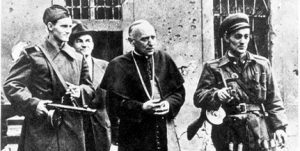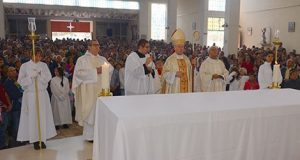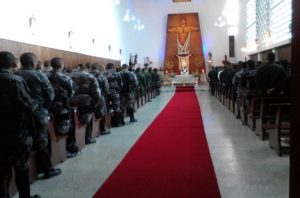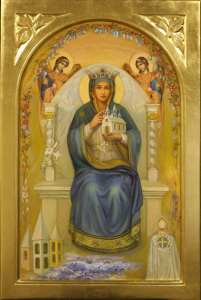Saint Peter Fourier
Feast Day December 9th
Parish Priest, Reformer of the Canons of Saint Augustine, Founder of the Canonesses of Notre Dame (1565-1640)
This priest of God was consecrated to Him before and at his birth by his pious parents. Fourier was born on 30 November 1565 in the village of Mirecourt, in what was then the Duchy of Lorraine, a part of the Holy Roman Empire (now the French department of Vosges), which was a bulwark of the Catholic Counter-Reformation. He was the eldest of the three sons of a cloth merchant and his wife, who were faithful Catholics. At the age of 15, his father enrolled him in the new Jesuit University of Pont-à-Mousson (eventually merged into the University of Lorraine).
His aptitude for study, his high stature and beauty added the gifts of nature to those of grace. The young man was noted in particular for his devotion to the Mother of God and his great modesty. It was a surprise to all when he chose to consecrate himself to God in a religious Order which at that time had degenerated from its original fervor, that of the Canons of Saint Augustine. He made application for entrance into the Abbey of Chaumouzey, founded in 1094, situated a short distance from his native village of Mirecourt in Lorraine. There he made the traditional vows of poverty, chastity and obedience in 1587, and was ordained a priest in February of 1589.
Before saying his first Mass he passed several months of retreat in the exercises of prayer, penance and tears. He was then sent to complete his theological studies at the University of Pont-au-Mousson, also in Lorraine. There, Father Jean Fourier, a relative who was Rector of that University, directed him admirably. His progress in virtue and the sacred sciences placed him high in the opinion of the Cardinal of Lorraine and Bishop of Metz, who desired to have him in his diocese; he offered him a parish where his talents would bring him advancement. But the young priest, wishing to flee all honors, declined, to return to his Abbey.
There, hell instigated against him a persecution; he was the brunt of raillery, threats, and intrigues, and an effort was made to poison him, which did not succeed. For two years he lived in the midst of contradictions without complaining in any way to his abbot, who seemed unaware of what was happening; he increased in patience and kindness towards his persecutors. Eventually he was again offered a choice of three parishes, two of which would provide opportunity for advancement, while the third was in a village regarded as incorrigible and backward.
Fourier passed over two prestigious options and accepted the post of vicar of the parish of Mattaincourt in order to combat the indifference to religion widespread in the town, and to counter nascent Calvinism in the area. He went on to spend the next twenty years of his life serving its people.
The Sacraments were neglected and the feast days profaned; the altars were bare and the church was deserted when he arrived.
Fourier was charged with preaching to the people of the Principality of Salm-Salm, which had embraced Calvinism. Within six months his gentle persuasion and efforts were rewarded with the re-establishment of Catholicism in the realm.
To this end, Fourier instituted two major reforms that showed his intelligence and concern for his flock. The first of these was to improve the financial lives of his community by setting up a community bank, from which the townspeople could borrow without interest. His motto in serving the parish was to feed only one person was of use to all. His second innovation was in his preaching style, where he employed dialogues with small groups of his parishioners to explain better their Catholic faith to them. He had his pupils engage in dialectics on Sundays on the various virtues and vices in practice by the congregation. This style proved immensely successful.
He instituted three sodalities, of St. Sebastian for men, of the Holy Rosary for women and of the Immaculate Conception for girls, or “Children of Mary”.
He began by visiting families and assembling two or three of them to talk to them of the truths of the faith. He did not go to the banquets which followed funerals and weddings, save to offer the prayer of blessing or make a short exhortation. He did not accept a housekeeper, even when his own stepmother offered to assist him. He prayed for the greater part of every night, and never refused to go where he was called, at any time or in any season. So little did he need for himself that he was able to give alms and assistance to the poor. He prayed before Jesus on the altar: You are the principal parish priest, I am only Your vicar. And permit me to say to You, with all the humility of my heart, that You are under obligation to make succeed what I cannot.
He desired to remedy the evils of the times by forming children to virtue; and Providence soon brought to him several young women who offered themselves for the instruction of young girls. Within the space of only a few years, six schools were founded in the region, and before he died, about forty. Blessed Alice LeClerc was the first Sister and first Superior of the Canonesses of Notre Dame, dedicated to the education of young women. For this purpose Saint Peter was obliged to confide his parish to his vicar for a time, to journey and obtain the various permissions and assistance necessary; but it was God’s work and all efforts succeeded.
His own parish was gradually being transformed into a model, and priests came to visit it. One of them reported to his bishop the marvels of devotion he had seen in Mattaincourt, and said he had asked the parish priest where he had studied; Saint Peter had answered that he had studied in the fourth — corresponding in America to about the ninth grade. Astonished, the visitor was yet more so when he learned that this modest priest had certainly studied in the fourth, as he had said, but out of horror for vainglory had wanted to dissimulate his years of higher studies.
The bishops were asking him to visit their parishes to preach missions where needed; the holy priest obeyed, amid his increasing tears and penance, as he perceived the vices and ignorance of the populations. He also was concerned to reestablish the discipline and fervor of his own Order, an effort which had failed several times. But in 1621 the Bishop of Toul, Monsignor de Porcelets, entrusted this work to Father Fourier. A house was found to begin the Reform, the vacant ancient Abbey of Saint Remi, and six excellent subjects were sent there under his direction. In four years, eight houses of the Order had adopted the Reform. A General Superior was named; for a time Father Fourier was able to avoid that office, but when the good Superior died, he was obliged to accept its functions. Attacked by the devil, his influence distorted by calumnies, Saint Peter’s only response was to spread everywhere devotion to the Immaculate Conception of the Blessed Virgin. More than two centuries before the Miraculous Medal in 1830 and the proclamation of the dogma in 1854, he saw to the distribution of large quantities of a medal he had struck, on which were engraved the words: Mary was conceived without sin.
Saint Peter Fourier died in exile as an effect of the difficulties and political problems of the 1630’s; he found shelter in a province which was at that time under the Spanish crown, and there he died in 1640. His spiritual sons, his spiritual daughters, the good people of Gray in Bourgogne, who had welcomed him and whom he had served admirably during an epidemic of the pestilence, all wanted the honor of possessing his mortal remains. But so did also the parish of Mattaincourt. To the reformed Order of Saint Augustine this privilege was granted officially, but the pious women of Mattaincourt, blocking the church door, would not permit the Canons to resume their journey with the coffin, after they had stopped in his former parish for a day or so. His heart had already been left to the parish of Gray. Miracles have abounded at his tomb, as they did during his lifetime, by his prayers. He was canonized by Pope Leo XIII in 1897.
References and Excerpts
[1] Les Petits Bollandistes: Vies des Saints, by Msgr. Paul Guérin (Bloud et Barral: Paris, 1882), Vol.
[2] “Peter Fourier.” Wikipedia. Wikimedia Foundation, 13 Nov. 2016. Web. 12 Dec. 2016.
[3] Allaria, Anthony. “St. Peter Fourier.” The Catholic Encyclopedia. Vol. 11. New York: Robert Appleton Company, 1911. 12 Dec. 2016 <http://www.newadvent.org/cathen/11767b.htm>.
[4]Online, Catholic. “St. Peter Fourier – Saints & Angels – Catholic Online.” Catholic Online. Catholic Online, n.d. Web. 12 Dec. 2016.
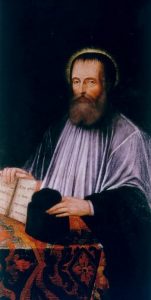
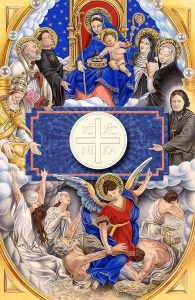 Pray for your priest and Church.
Pray for your priest and Church. Bestow Mercy to Revitalize the Communion of Saints.
Bestow Mercy to Revitalize the Communion of Saints.
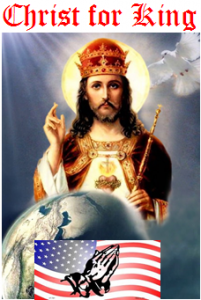 Christ for King of the United States
Christ for King of the United States

